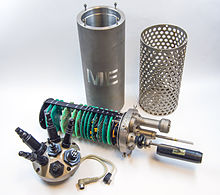CTD rosette
The CTD rosette (from English Conductivity, Temperature, Depth , "conductivity, temperature, depth") is a probe for deep-sea investigations .
It is usually lowered (“lowered”) by oceanographers from research vessels on a long rope to a depth of several thousand meters.
The rosette consists of a cylindrical frame equipped with sensors for temperature , conductivity and water pressure . From this, further basic parameters of density , salinity and water depth can be calculated. Additional sensors such as B. opacimeters , oxygen meters and acoustic flow meters can be attached.
When pulling up the CTD rosette from a great depth of water, water scoops can be closed in different water depths. Thus, these samples can be examined for trace substances and microorganisms according to the respective water depths .

